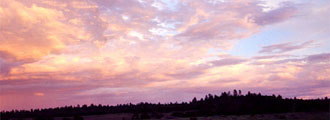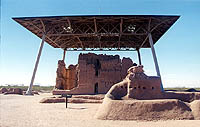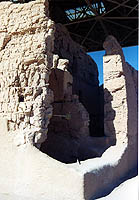Casa Grande Ruins became the nation's first archeological
preserve in 1892. It is a Hohokam Ruin. "Hohokam" is a term that
was apparently applied when the Pima Indians stated their
ancestors were Hohokam (meaning all used up and or all gone).
Casa Grande Ruins National Monument contains one of the few surviving Hohokam structures
built by this ancient civilization. While not
much is known, the ruin is estimated to be over 650 years old.
By about 300 AD, a distinct culture was in place
along the Gila and Salt Rivers. The inhabitants built houses and ballcourts. They also dug an elaborate system of irrigation ditches that were so effective that they
were used by early pioneers in the area hundreds of years
later. Some of these can still be seen today. By about 1450 the Hohokam were gone, leaving behind the
remnants of a great civilization.
Casa Grande is constructed of Caliche and wood. Caliche is a desert
concrete made of sand, clay, and calcium carbonate. Caliche
is so hard it has caused problems for many modern day homebuilders.
The name Casa Grande (Spanish for Big or Great House)
came from one of the early exploring Spanish priests, Father Eusebio
Kino. The actual structure is currently 4 stories high and
60 feet long, with walls over four feet thick at the base. The walls face the four cardinal compass points., and various openings within the
wall align with both the sun and the moon at certain times
of the year,such as the summer solstice. Scientists think these
openings may have been used to determine when to plant crops, when to harvest
the crops, or perhaps for other purposes, including ceremonial.
Casa Grande today is protected from the elements by a large steel
structure. The site includes a ball court as well as the remains
of several additional structures.
Location: Coolidge, Arizona. About 1 hour southeast of Phoenix. I-10
to the Coolidge exits. Follow the signs.
Weather: This is Desert. Summer temperatures can easily exceed 100 degrees
during the summer months.
|



